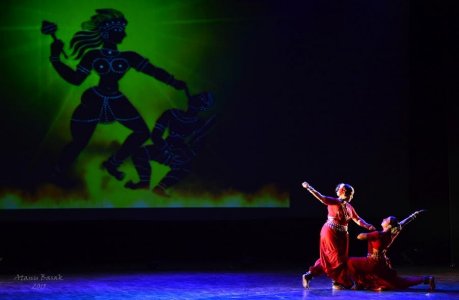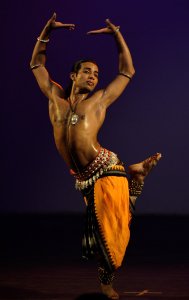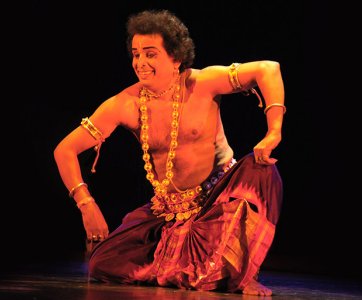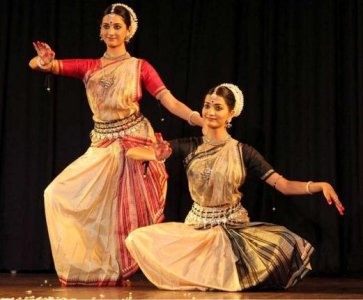
|   |

|   |
Odissi Dance Festival 2016 organised by Shinjan Nrityalaya - Nita Vidyarthi e-mail: nitavidyarthi@gmail.com April 4, 2016 Kolkata had the opportunity to witness the performances of some of the best Odissi dancers of the country, during the three-day Odissi dance festival (Jan 26-28) organised by Shinjan Nrityalaya, spearheaded by the city based Odissi dancer Aloka Kanungo. The festival supported by the Ministry of Culture, Government of India and EZCC at Rabindra Sadan was graced by guests-of-honour, Atri Bhattacharya, Principal Secretary, Information and Culture, Government of West Bengal and Dr. Om Prakash Bharti, Director EZCC. The opening performance was the invocation “Vakratunda Mahakaya” by Sujata Mohapatra, choreographed by Guru Ratikant Mohapatra. This was followed by ‘Jatayu Moksha,’ a Guru Kelucharan Mohapatra masterpiece from the Ramayana set to music by Pandit Bhubaneswar Misra. One of the best dancers of the present generation, Sujata with her knowledge and deep understanding presented the maestro’s choreography with total devotion and exquisite versatility in the multiple roles of Sita, Rama, Maricha, Ravana, Jatayu and others, effortlessly changing facial expressions and deportment in the different roles she portrayed. Her impactful abhinaya as Ravana and the dying Jatayu obtaining salvation (moksha) from Lord Rama, brought forth the valour and the poignancy of the characters simultaneously through an extremely refined execution. The piece saw some very intricate play of rhythms in the nritta that was woven into the choreography.  Shakti by Shinjan Even though senior Shinjan student Kaberi Sen did not make an impression with her solo, the juniors of Shinjan gave a well-rehearsed performance of Batu. The home production ‘Shakti’ embracing the Tantric philosophy celebrating the female energy directed by Aloka Kanungo was a spectacular production with power point presentations and the incorporation of the dying art of Ravana Chhaya, a rare form of shadow-theatre surviving in Odisha, projected on the cyclorama at the back of the stage. This reinvestment of the traditional art form made the piece special. Use of Sabdas in the sabda nritya was a welcome addition. Use of wooden sticks and lengths of cloths to represent blood was interesting. The music was by Ramhari Das and graphics by Dinanath Pathy.  Rahul Acharya The venue changed to Kalamandir for the rest of the festival. Gurus Kumkum Mohanty and Thankamani Kutty were the guests-of honour for the second evening which opened with a scintillating recital by the brilliant Rahul Acharya. With his command over the techniques he gave an excellent account of himself embracing the Debaprasad Das style and brought alive the temple sculptures of the musicians through his crisp and precise Nritta-Ektali “sthyai”- with no song but with a set pattern of rhythms. “Ashtashambhu” using eight verses of Venkateshwara Dikshitar and Shabda-swarapata was a captivating presentation with Rahul dancing passionately with unbelievable confidence and rhythmic flourish. Specially memorable was the skilful eulogy of Shiva in its many dramatic poses and the interpretation of “Himadri nikatey Dakshadhoja dhangshini,” “Marang barayatey, marang marayatey” encompassing the stage with vigorous grace and gradually moving the hands forward from the back to salute “Mahadevaya tudhow namoh.” Sriparna Bose of Shinjan tried hard to bring out the underlying poetry of Kavi Banamali’s melodious Odia song “Kahin goley Murali phunka” set to raga Mishra Desh but her abhinaya needs more attention. A breath of fresh air in terms of composition, text, music and ecru costume to the Odissi scenario was brought by the talented Phagre sisters, Kalyani and Vaidehi, disciples of their aunt Bindu Juneja from Bhopal in their well coordinated duet. The accompanying music by Professor Meera Rao and the slokas were from the Rig and Atharva Veda and embraced the “Dwaita-Adwaita” concept to express the higher wisdom of the mind. The long philosophical piece echoing “mangalam sumagalam” choreographed by Juneja was dignified and the dancers did full justice to it. ‘Shiva tandava stotram’ in praise of Lord Shiva expressed the metaphysical profundities of the lyrical sensuousness of Odissi and the competent presentation unravelled the myths and legends of the Jagannath (addressed as “Daru Brahma”) cult. Freezes adorned with sculpturesque poses especially the tribhangi were a visual pleasure. The presentation concluded in the Vaishnavite tone with a Surdas composition. Batu composed for the first time in tala triputa by none other than Guru Kumkum Mohanty was presented by her group but the performance was amateurish. Muralidhar Swain was on the mardal, Agnimitra Behera on the violin and rhythm was composed by Sachidananda Das. The popular Odia abhinaya “Ki shobha go kunje” set to Pandit Bhubaneswar Misra’s music with rhythm composition by Sachidananda Das did not rise above mediocrity. The concluding evening was a delightful experience with rewarding performances by veteran dancers. The renowned Sharon Lowen was extremely graceful in the soulful ashtapadi “Sakhi hey, Kesi mathanamudaram” choreographed by Guru Kelucharan Mohapatra, set to Pandit Bhubaneswar Misra’s music. In this piece elaborating Radha’s love for Krishna, Sharon was deeply sensitive in “chakita bilokita sakala disha.” Sharon concluded with a touching, spiritually powerful Balamurali composition, “Om Karakarini” based on raga Lavangi with “Omkarakarini moksha” set as the finale. Baishali Koley, a senior disciple of Aloka Kanungo proved her training and skill in pure dance, in the ektali Behag Pallavi negotiating the intricate rhythmic patterns with ease.  Sharon Lowen  Kaori Naka  Gajendra Panda  Phagre sisters A surprise in the form of a talented Japanese Odissi dancer Kaori Naka was in store for the audience in the next thundering “Ardhanariswar.” The duet Kaori performed was together with her Guru Gajendra Panda who also composed it and was one of the richest power packed performance of the festival in the Debaprasad Das style interspersed with Sabda-swarapata (Shiva tandava set to music and sung by Lakshmikant Palit). Kaori is gifted with both power and grace and performed with confidence in perfect cohesion with her acclaimed guru whose elevated performance (tandava), needless to say was highly rewarding. Gajendra Panda’s impassionate solo “Manoudharana, karo hey tarana,” an abhinaya penned by kavi Upendra Bhanja in raga Misra Pahari, taal triputa, displayed the sensitivity, artistry and high calibre of the veteran. The torch bearer of the Guru Debaprasad Das style, it was a privilege watching this distinguished dancer’s astonishing abhinaya abilities, especially while pleading to Lord Jagannath as “Anathero nath” and “Jagannath naam nilachaley.” Yet another memorable abhinaya by Gajendra was the reverberating victorious laugh of Duryodhana in the ‘Game of Dice’ set to “Kuru sabha thaley Draupadi chintila.” The soul stirring piece ended with the bhakta lying prostrate (sashtanga pranam) saluting Lord Jagannath. The curtain came down with two well rehearsed presentations by Meera Das and her excellent troupe from Cuttack. The rhythmic composition of the pure dance item Desh Pallavi in taal rupak performed by the talented group was composed by Sachidananda Das and choreographed by Meera, who has retained the purity of the original composition by Guru Kelucharan Mohapatra and laced it with outstanding improvisations. The six well-trained female dancers with lovely sea-green costumes deserve all the praise for their competent performance, especially while negotiating the tihais. ‘Dasavataar’ is always a very popular piece and following Jayadeva’s Gita Govinda, Meera Das rearranged Guru Kelucharan Mohapatra’s choreography to a superb well executed composition set to Pandit Bhubaneswar Misra’s music. The imagery of “Kacchapa rupa and Buddha sharira” was praiseworthy. It was a pleasure watching Meera perform. With such fine quality of artists and high quality of performances, the low audience density was disheartening. Perhaps a number of simultaneous performances in the city may have been the cause. A difficult proposition though, one missed a solo performance by the organiser-host, Guru Aloka Kanungo! Dr. Nita Vidyarthi is a regular contributor to The Hindu and the Statesman Kolkata in dance, vocal music and theatre. She is trained in Kathak, Bharatanatyam and Manipuri as well as vocal, semi-classical music and Rabindra Sangeet. A Science communicator, Ph.D. in Polymer Science, Commonwealth Scholar and a retired Professor of Chemistry, Nita devotes most of her time to dance and theatre writing. |